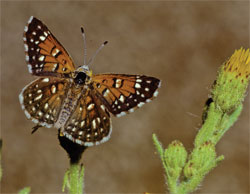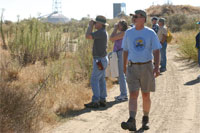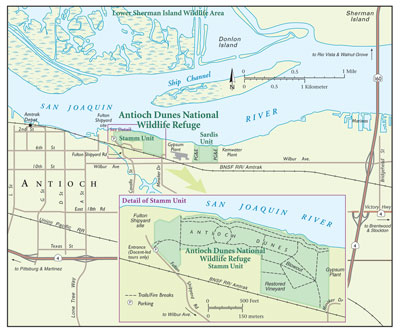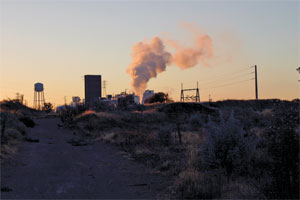Standing at the entrance of the Antioch Dunes refuge last fall, I knew that the 10-foot chain link fence in front of me could only have been built for two reasons: to keep wildlife in, or to keep people out. Since the refuge was created to protect a few rare plants and an endangered butterfly, the answer is obvious: After decades of sand mining, trampling, and repeated wildfires fueled by invasive weeds, fencing out the public seems the least we could do for the handful of endemic species barely hanging on within.
But for over a year now, refuge managers have been unlocking the gate to lead monthly hikes, letting the public into this unique habitat for the first time in more than 15 years. “We really wanted to embrace the citizens of Antioch and let them know they have this great resource in their backyard,” says refuge biologist Rachel Hurt.
Over the past few weeks, I’ve had the opportunity to explore this unlikely refuge set in the midst of Antioch’s industrial waterfront on the San Joaquin River. Wandering along the hardpan trails in stands of silvery bush lupine, buckwheat, and telegraph plant, I’ve already caught a glimpse of the refuge’s endangered endemic Lange’s metalmark butterfly (Apodemia mormo langei), Contra Costa wallflower (Erysimum capitatum spp. angustatum), and Antioch Dunes evening primrose (Oenothera deltoides spp. howellii). All found here, and here alone.
The unusual inhabitants of what is now the Antioch Dunes National Wildlife Refuge (ADNWR) attracted biologists as far back as 1869, but, regardless of all I know about the once-great dunes beneath my feet, I’m having a hard time shaking the feeling I’m standing in a vacant lot.
- The refuge is hemmed in by the neighboring gypsum plant and several other industrial facilities. Photo by Sarah Anne Bardwell.
Along the outskirts of Antioch, the refuge’s 55-acre Stamm Unit and 12-acre Sardis Unit lie trapped like two pieces of a puzzle between the former Fulton Shipyard to the west, the Kemwater Plant to the east, a retired sewage treatment plant and railroad tracks to the south, and the Georgia-Pacific Gypsum Plant in their midst.
These dunes—covering today perhaps a quarter of their historic extent—are part of a haven established by the United States Fish and Wildlife Service in 1980, the first refuge created specifically to protect plants and insects. But don’t be fooled by the refuge’s name; the remnant dunes are molehills compared to the mountainous drifts that once stood here. And these days, bare sand—once the dunes’ defining characteristic—is hard to come by. But the unusual plants and insects—along with a stunning view of the river—still give this place an allure all its own.
Over the last 500,000 years, these ancient sands were created by glacial action in the Sierra Nevada, then flushed down creeks and rivers until they settled out of the water column and blew and washed ashore along the glacial-age floodplains. From there, prevailing winds swept the sands east, accumulating along the banks of present-day Antioch. Although such dunes might have repeatedly formed here five times or more, today’s dunes likely formed within the last 140,000 years. At their height, they towered some 120 feet above sea level, extended approximately 800 feet inland, and stretched more than two miles along the San Joaquin River’s southern bank.
This island of dunes wasn’t always completely isolated. Immediately south of the Antioch Dunes, a lesser dune system once stretched from the foothills of Mount Diablo eastward to the banks of Marsh Creek, then south along the western edge of the Central Valley. Biologists theorize that some 5,000 to 8,000 years ago, desert plant and animal species worked their way northward from the Mojave Desert along arid habitat corridors such as these during dry, interglacial periods, eventually colonizing the Antioch Dunes.
Climate change and other natural processes, followed eventually by humankind’s agricultural practices, led to the gradual isolation of the Antioch Dunes. Left to their own, species such as Lange’s, the evening primrose, and the wallflower drifted away from their southern ancestors and evolved over time to become the localized endemic species we recognize today. These species distinctions are subtle, and some plants, like the naked stem buckwheat (Eriogonum nudum var. auriculatum), are only now on their way to being recognized as distinct species.
Though they’ve been biologically isolated for millennia, the dunes have long been influenced by human habitation. Spanish explorers in the 1770s reported visiting Native American villages here. Later, under the Los Megaños Land Grant in the mid-1800s, settlers established Smith’s Landing—Antioch’s antecedent. Since then, several sand mines, brickyards and a piggery, dairy, sheep fold, vineyard, shipyard, paper mill, the Little Corral Bar, and a track field all have had their day.
The most destructive of all these activities were the brickyards and sand mines, both of which exhausted parts of the dunes down to their underlying hardpan. Following the 1906 earthquake, much of San Francisco was rebuilt with bricks of Antioch Dune sand, and, later in the 1930s, sand was shipped to the horse tracks at Golden Gate Fields. The remnant dunes now reach heights of 50 to 80 feet at best.
Sand mining ceased the day before the refuge was officially established, but that wasn’t enough to protect the dunes. In 1986, six years after the refuge opened, limited staff, wildfires, and trampling forced the Service to restrict public access to the dunes.
During the recently-inaugurated monthly tours, volunteers like software salesman Michael Krieg have been leading the public through the refuge in search of the evening primrose or the elusive Lange’s. Krieg showed me around, cheerfully pointing out the wheat versus the chaff.
There’s a lot of wheat, to be sure; lush stands of native naked stem buckwheat—the larval food plant for Lange’s metalmark butterfly—appear to be thriving, glowing flaxen in the crisp morning air. Clusters of silvery bush lupine dot the dunes. Like quicksilver prisms, the lupine leaves glimmer and glint with the sun.

- The naked stem buckwheat is the larval food plant for the Lange’s metalmark butterfly. Photo by Richard Arnold
Elsewhere along the trail we spot stalks of telegraph weed, pallid California poppies, and red-stemmed deerweed. Together, these and other natives make up the refuge’s unique natural habitat. Many such plants are tied to the ever-shifting, windblown sands. The Antioch Dunes evening primrose, for example, requires a dynamic, disturbed substrate for its seedlings to germinate. Similarly, along the north-facing river bluffs, Contra Costa wallflowers emerge from the unstable slopes where other plants are hard-pressed to compete.
Given the vastly diminished sands, the view here is quite different from the one that greeted Spanish Captain Juan Bautista de Anza’s expedition in 1776. Faced with the prospect of crossing the river or the vast tule marshes to the east, the explorers realized they could go no farther north than those very sands. Before turning back, expedition member Padre Font described in his diaries the characteristic sierra emboscada, or “wooded ridge,” of coast live oaks that then peppered the dunes.
A similar stand of oaks grows today on the “Pit Floor” of the Sardis Unit, a floristic reminder of the past. The topography here is much like it was decades ago. A good portion of this sand was never mined because of the transmission towers built in 1907 and 1927. Down in the pit, the oaks grow closely enough to form a veritable woodland.
On the Stamm, oaks like these were felled and sold years ago for cordage. The venerable oak that stands sentinel along the Stamm’s bluffs is one of the few that remain. Although the oaks stabilize the dunes—potentially making it more difficult for the primrose and wallflower to thrive—slumping, erosion, and natural weathering provide enough disturbance and exposed sand for these plants to become established.
The same can’t be said of the exotic grasses and vetch that now carpet parts of the dunes like Astroturf. Before European nonnative weeds like wild oat and red-stemmed filaree—first recorded here in 1853—were introduced, the dunes were sparsely vegetated: here and there, as you’d expect in a desert landscape. Now, a suffocating ground cover stabilizes what’s left of the dunes, absorbing water and trapping what should be wind-borne sands in the weeds’ moist root-balls.
Just inland, across a former vineyard where hard-bitten vines still creep across the ground, a hilly series of artificial dunes protrude from the otherwise low-lying terrain. Even these sands, imported as part of several mitigation projects, are rife with weeds. Outside the perimeter fencing, Russian thistle and vetch crowd the chain links, jockeying for a chance to cast their seeds into the refuge.
Farther on, we come across a specimen of Antioch Dunes evening primrose in the middle of the trail. Late into September, snow-white evening primrose petals continue to unfurl, weeks after the plant should have closed up for the season. Oddly enough, the trails offer the primrose some sandy elbow room amid its weed-choked surroundings.

- During a September tour of the refuge, docent Michael Kriegguides visitors searching for the federally endangered Lange’smetalmark butterfly. Photo by Sarah Anne Bardwell.
Each year, refuge manager Chris Bandy realigns the trails to accommodate opportunistic natives like this primrose. For Bandy and Hurt, stemming the onslaught of weeds and wildfire could be a full time job—but these two are also responsible for managing the least tern colony at the proposed Alameda National Wildlife Refuge. So it’s only with the support of a dedicated cadre of volunteers that Bandy and Hurt can take on annual population counts, restoration, upkeep, and the prevention of trespassing.
The upkeep of the trails is critical to the refuge’s future. They’re not only footpaths; they’re also firebreaks. Since 1999, weed-fueled wildfires ignited by stray sparks and trespassers’ campfires have repeatedly reduced portions of the dunes to stubble. Now, the firebreaks are a necessary evil. Although they further fragment the already fractured habitat, they’re the only line of defense to keep fire from spreading between the management units.
The dunes’ unique assemblage of flora and fauna has attracted naturalists for more than a century. Albert Kellogg, cofounder of the California Academy of Sciences, was the first to botanize the dunes in 1869. Beginning in 1929, the remarkable insect fauna attracted entomologists from the Academy and the University of California. All told, their collecting efforts led to the discovery of 27 new taxa of insects. Several of these species were recorded then for the first and last time, remembered today only by the preserved specimens collected during these early forays.
Eight insects are—or were—endemic to the Antioch Dunes. Of these, four are extinct. Scientists don’t know the status of three species—Middlekauf’s shieldback katydid, Antioch weevil, and Colletes turgiventris, which lacks a common name. And it was the dwindling numbers of the eighth—Lange’s metalmark butterfly—that helped bring the refuge into existence. Now, the question remains: Can the last known endemic insect survive on so small a plot of land?
Even though it’s September, when butterfly numbers have passed their prime, we’re fortunate enough to catch a glimpse of the metallic-orange, flittery specter. It alights on a buckwheat plant and instantly melds into its surroundings. In moments, we’ve lost sight of this apparition altogether.
The Lange’s erratic flight is one of its trademarks, which helps participants in annual counts distinguish the species from more common butterfly visitors. But since these butterflies are capable of ranging at most a thousand feet from their home base, they are confined to the refuge. Though they might be able to survive on other types of buckwheat, there simply aren’t any satellite buckwheat populations in the surrounding industrial/residential areas.
The Lange’s metalmark butterfly was first listed as a federally endangered species in 1976. That same year, the Antioch Dunes were designated as “critical habitat” for the species. In 1986, Service personnel and volunteers counted a total of 187 Lange’s at their population’s annual peak. By 1999, the peak population count hit 2,342 butterflies, the highest count recorded to date. But in 1999, a trespasser’s campfire along the riverfront burned 10 acres of prime Lange’s habitat in the Stamm. In the wildfire’s wake, peak Lange’s counts have steadily declined from 1,185 in 2000 to 521 in 2003, and an alarming 452 butterflies in the fall of 2004.
In the face of more than 100 years of misuse, this sandy oasis persists today in the industrial outskirts of Antioch. Despite the scars wrought by mining and wildfire, woodlands have erupted from the sands, primroses persist amid the firebreaks, and, on a wing and a prayer, Lange’s metalmark may yet stage a comeback. Standing here on the bluffs, I try to imagine the dunes as they might have been, and what they might yet become. Refuge biologist Rachel Hurt may have been on to something when she called this place “the Jewel of Antioch.”

- map by Ben Pease
Getting There:
ADNWR is closed to the public except for volunteer-led tours on the second Saturday of every month. Call for details: (510)521-9624. Heading east on Highway 4, take the Lone Tree Way/A Street exit; turn left onto A Street and head north. Stay in the right-hand lane. Immediately following Ninth Street, turn right onto Wilbur Avenue, then left on Fulton Shipyard Road. Limited parking is available at the Stamm’s entrance.

.jpg)




